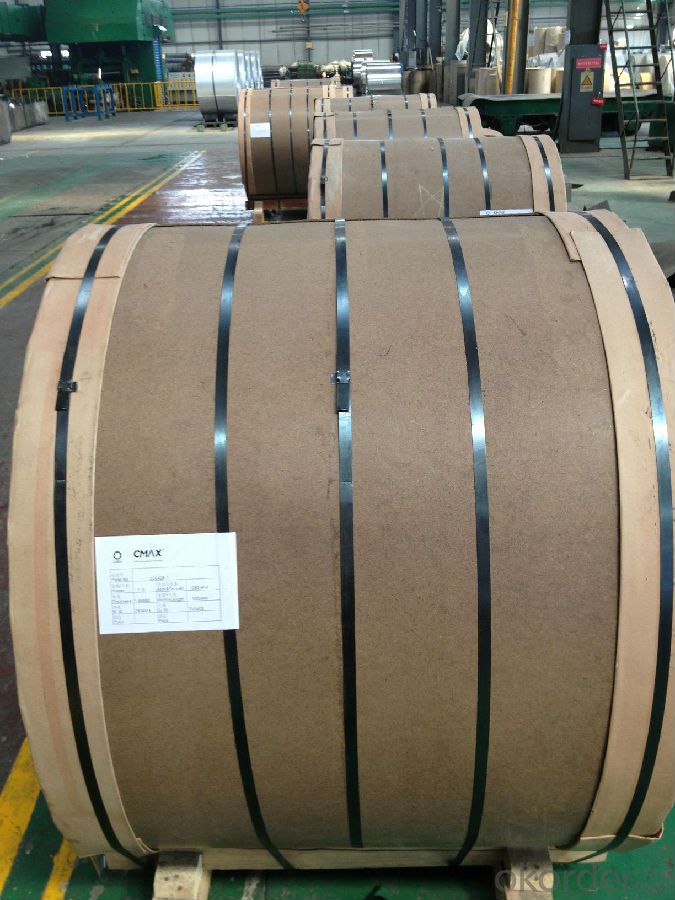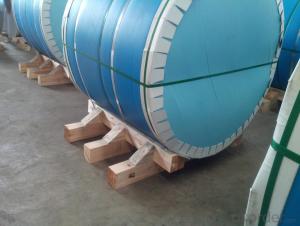Mill Finished Hot Rolled Aluminium Strip AA5052
- Loading Port:
- Shanghai
- Payment Terms:
- TT OR LC
- Min Order Qty:
- 5 m.t.
- Supply Capability:
- 5000 m.t./month
OKorder Service Pledge
OKorder Financial Service
You Might Also Like
1.Structure of Product Description
Mill Finished Hot Rolled Aluminium Strip is one semi-finished aluminium material. This strip can be rolled down to aluminium coil,sheet,circle ect. And AA5052 is widly used in Ships building, industry ect, sometimes it also can used in the beer cans. Its weight is much lower than steel. So many customers choosed aluminium material instead of steel.
2. Main features of the product
a.Competitive price---We have our own mills and can produce mill finished aluminium coils, so we can control the production cost better.
b.Professional after-sale service---We have more than 15 years exportation experience and you need not worry about the exporation problems.
c.Fast delivery time---We can control the delivery time within 35 days.
3. Image:



4.Products Specification
| Alloy | Thickness | Coil ID | Coil Weight | Main Usage |
| AA5052 | 0.2mm-3mm | 508mm+/-10mm | 2-2.5 tons | Ships |
5.FAQ:
What is the quality standard?
---Usually our standard is GB3880-2006
What is the largest width?
---It is 2300mm
What is the MOQ?
---Usually we can accept 80 tons.
- Q:Are aluminum sheets suitable for elevator interiors?
- Yes, aluminum sheets are suitable for elevator interiors. Aluminum is a durable and lightweight material that is resistant to corrosion, making it ideal for use in elevator interiors. It can be easily customized and offers a sleek and modern aesthetic. Additionally, aluminum is easy to clean and maintain, making it a practical choice for elevator interiors.
- Q:Iron is extracted from iron oxide by displacement with carbon.But aluminum is not extracted from aluminium oxide using displacement by carbon. Suggest a reason for this.
- Well, de facto because the heat of formation of aluminum oxide is so much greater than the heat of formation of iron oxide. If you're looking for something more mechanistic, find Al and Fe in the periodic table. Al and Fe are in different rows, and Fe is larger than Al, so although Al+3 and Fe+3 have the same charge, oxygen bonds less strongly to Fe+3 than to Al+3 because it's further away from the nucleus of Fe. Al+3 has no outer shell electrons at all; 3s, 3p, and 3d subshells are all empty. It's effectively a charged sphere with nothing to interfere with bonding. Fe+3 (as in hematite, Fe2O3) is larger, has filled 3s and 3p subshells, and a half-filled 3d subshell. That 3d electron density projects pretty far out into space, holding oxygen at arms length. Aluminum has no electron density in 3d orbitals, so oxygen can tuck in nice and tight and get a good grip. Any of these hit the mark? I don't know what background you're bringing to this question.
- Q:How do you prevent oxidation of exposed edges of aluminum sheets?
- There are several effective methods available to prevent oxidation of exposed edges on aluminum sheets: 1. Applying a protective coating is a commonly used approach. Various types of coatings like paint, lacquer, or specialized protective coatings designed for aluminum can be used. These coatings act as a barrier, preventing contact between the aluminum, oxygen, and moisture, which are the main causes of oxidation. 2. Anodizing is another option. This involves subjecting the aluminum sheets to an electrolytic process, creating a controlled and thick layer of oxide on the surface. This layer acts as a protective barrier against oxidation and offers additional benefits like improved corrosion resistance and enhanced aesthetics. 3. Proper storage and handling practices are crucial. Aluminum sheets should be kept in a dry and well-ventilated area, away from moisture and humidity. It is important to avoid placing them directly on the ground or other surfaces that may expose them to moisture. Additionally, wearing gloves during handling can minimize the transfer of oils from the skin, which can accelerate oxidation. 4. Regular cleaning and maintenance play a significant role in preventing oxidation. Removing dirt, grime, and other contaminants from the surface is essential as they contribute to the oxidation process. Mild soaps or detergents and a soft cloth or sponge can be used for cleaning. Thoroughly drying the sheets after cleaning is important to eliminate any remaining moisture. By implementing these preventive measures, the oxidation of exposed edges on aluminum sheets can be effectively minimized. This ensures their durability and preserves their aesthetic appeal.
- Q:i want to build a smelter to recycle aluminum auto parts
- Tita, while providing an elegant answer, forgot to mention that it is mostly cut and paste from Wikipedia. I'll provide the link for her below. She also forgot to copy and paste the part about aluminum oxidizing easily when it is heated and melted. If you are trying to smelter aluminum, you will need to have a compressed or dense mass of aluminum and a smelter that is airtight. Otherwise, it will just oxidize right back into aluminum oxide, which is a white powder. You've probably seen this when you throw a beer can in the campfire? good luck and have fun in your endeavors. And always remember to cite your source!
- Q:Are aluminum sheets suitable for architectural applications?
- Architectural applications can indeed benefit from the suitability of aluminum sheets. Aluminum, being a versatile material, offers numerous advantages for architectural projects. It possesses a lightweight quality while still being strong, making it easy to handle and install. Furthermore, its resistance to corrosion makes it ideal for outdoor applications that are exposed to the elements. The malleability of aluminum sheets allows them to be easily formed into different shapes and sizes, enabling architects to create innovative and creative designs. These sheets find their use in various architectural applications such as cladding, roofing, facades, as well as interior elements including ceilings, partitions, and decorative components. Moreover, architects have the freedom to choose from a wide range of finishes for aluminum sheets, including anodized, painted, or coated. These finishes not only enhance the aesthetics of the projects but also improve the material's durability and color retention, thereby ensuring long-term performance and minimal maintenance requirements. Beyond these advantages, aluminum is also a sustainable material. It is fully recyclable and has a lower carbon footprint compared to other metals. This aligns with the growing emphasis on environmentally-friendly construction practices in the architectural industry. In conclusion, due to their lightweight nature, strength, corrosion resistance, versatility, range of finishes, and sustainable attributes, aluminum sheets are highly suitable for architectural applications. Architects can confidently incorporate aluminum sheets into their designs, resulting in visually appealing and durable structures.
- Q:Are aluminum sheets suitable for food storage applications?
- Yes, aluminum sheets are suitable for food storage applications. Aluminum is a widely used material in the food industry because it is lightweight, durable, and has excellent thermal conductivity properties. Aluminum sheets are often used to make food storage containers, foil wrap, and trays. These sheets provide an effective barrier against moisture, oxygen, and light, which helps to preserve the freshness and quality of food. Additionally, aluminum is non-toxic and does not react with acidic or alkaline food, ensuring that the taste and safety of the stored food are not compromised.
- Q:Is aluminum sheet resistant to UV rays?
- Yes, aluminum sheet is resistant to UV rays. Aluminum naturally forms a protective oxide layer that acts as a barrier against UV radiation. This oxide layer helps to prevent the aluminum sheet from being damaged or degraded by exposure to the sun's UV rays. This makes aluminum sheet a suitable material for outdoor applications, where it can withstand prolonged exposure to sunlight without fading or deteriorating. Additionally, the reflective properties of aluminum further contribute to its UV resistance, as it can reflect a significant amount of the sun's rays, reducing heat absorption and potential damage.
- Q:on an hot day, which will stay cooler longer...aluminum, or copper? why?thanks!
- copper aluminum’s conductivity is lower than copper.
- Q:What are the different types of surface treatments for aluminum sheets in the marine industry?
- Some of the different types of surface treatments for aluminum sheets in the marine industry include anodizing, powder coating, chromate conversion coating, and painting.
- Q:What are the different methods of joining aluminum sheets without welding?
- There are several methods of joining aluminum sheets without welding, including adhesive bonding, mechanical fastening (such as screws or rivets), clinching, and using non-welding techniques like friction stir welding or laser welding.
1. Manufacturer Overview |
|
|---|---|
| Location | |
| Year Established | |
| Annual Output Value | |
| Main Markets | |
| Company Certifications | |
2. Manufacturer Certificates |
|
|---|---|
| a) Certification Name | |
| Range | |
| Reference | |
| Validity Period | |
3. Manufacturer Capability |
|
|---|---|
| a)Trade Capacity | |
| Nearest Port | |
| Export Percentage | |
| No.of Employees in Trade Department | |
| Language Spoken: | |
| b)Factory Information | |
| Factory Size: | |
| No. of Production Lines | |
| Contract Manufacturing | |
| Product Price Range | |
Send your message to us
Mill Finished Hot Rolled Aluminium Strip AA5052
- Loading Port:
- Shanghai
- Payment Terms:
- TT OR LC
- Min Order Qty:
- 5 m.t.
- Supply Capability:
- 5000 m.t./month
OKorder Service Pledge
OKorder Financial Service
Similar products
New products
Hot products
Related keywords





























